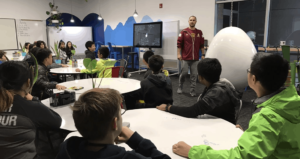The 3 Secrets to Scandinavian Innovation in Education

It’s 8:30 am on the first day of school. There are no bells to indicate the start of the day, or administrators hurrying the students into their classrooms. In fact, the school is completely empty.
Teachers, pupils, and administrators have shed their school attire in exchange for comfy t-shirts and colorful trainers. They are all busy playing group games in the forest nearby. After all, who would want to play the world’s largest game of Jenga in a button-up shirt and slacks?
The First Week of School in Scandinavia
I learned about the first week of school in Scandinavia from good friends and former colleagues at High Tech High, Loni Bergqvist and Tina Schuster. One spent time in Finland as part of a Fulbright scholarship to study innovation, and one was in Denmark for long-term consulting work.
I was particularly interested in what made the Nordic system of education so world-renowned. After all, four of the five Nordic countries have ranked continuously in the top 12 countries for education quality in 2018. And more, although comprising only .3 % of the world’s population, they contribute a disproportionate amount in the creative fields of music, game- design, and technological innovation.
Like Loni and Tina, I assumed their ingenuity had something to do with high standards, a rigorous curriculum, long school hours, unlimited funding, mandated testing and limitless tech. Instead, I learned these contributed little if anything to their success.
The magic of Nordic education lay entirely in the way they build relationships within their schools.
Here are what I believe to be the magic ingredients of Scandinavian education and the implications they have for us as educators:
Magic Ingredient #1: Autonomy to Innovate and Take Risks
No formal evaluations. No sitting for centralized exams until the age of 16. No measurement of children in their first six years of education. These are some of the hallmark characteristics of an education system that prides itself on autonomy and trust. In fact, in Finland, the average teacher spends only four hours a day in the classroom while the other hours are given to hone and refine their craft.
And while there is a nationalized curriculum that Scandinavian teachers follow, they are written as helpful guides, rather than the main feature. This creates a culture centered around growth rather than measurement. As Tina Schuster aptly puts, “I never got the sense from any teacher I spoke to that there was someone evaluating them from leadership.” Instead, leaderships’ main role was to provide the conditions that allowed them to thrive. For example, when one teacher wanted to institute a camping trip with students focused on survival, the response from the administration was, ‘Why not make it a regular thing?’
Students are also provided with this level of autonomy. During one of Tina’s observations, she noted that after a kindergartner arrived late to school in their snow boots and down jacket, the teacher simply stated, “You know what to do.” In five minutes, the child was out of his snow gear, seated and ready to work. This kind of autonomy is built through trust.
Questions for reflection:
Do you provide autonomy for your students and teachers? What systems or routines have you established to help foster this autonomy?
Magic Ingredient #2: Supportive and Egalitarian Community
‘Hey, Janet, what’s the homework for tonight?’ You might expect to hear this kind of exchange between two close friends. In Scandinavian schools, however, this is a question from pupil to teacher. Pupils are free to address their teachers by first names and are viewed as equals in the education partnership. As Loni Berqvist explains, it’s a ‘way to develop a friendly learning atmosphere in which learning is a communal experience.’
Perhaps that’s why for the entire first week of school, instead of opening a textbook, Danish teachers instead spend time building relationships with students through games, activities and ‘hygge;’ a Danish phrase that loosely translates into a ‘nice, cozy time.’
This ‘hygge’ continues in the classroom as students are free to design and decorate the classroom according to their preferences. That is because rather than move from class to class after each successive lesson, the students remain in the classroom, while the teacher moves to a new group of students.
Egalitarian relationships also permeate their way into teacher and administrator interactions as well. Tina Schuster explains that every day the whole school eats together in the cafeteria where students all receive a warm and healthy free lunch. Lunch was not a time to catch up on grading, but rather a time to build relationships with the school community. With equal pay, time off and professional development opportunities, it’s easy to view colleagues more as allies than adversaries. In fact, relationships are so communal that when one teacher requested to take a mental health break for a weeklong cross-country ski trip, the teachers banded together to pick up his classes.
Questions for reflection:
How do you promote equity and equality within your classroom and school? What time might you dedicate to strengthening those relationships?
Magic Ingredient #3: Balance School and Work Life
When I first started as a teacher, I attributed the minutes I spent planning, grading, teaching and thinking about school as directly related to my effectiveness as a teacher. After about year two, I realized I wouldn’t make it to year three if I didn’t change this unhealthy mindset.
Scandinavian countries know the value of balance.
For every 45 minutes of class, there is a mandated 15-minute break. According to Tina, this cycle worked like ‘clockwork,’ with everyone in school taking this same break regardless of role. You could even take this time to nap in the staff room (true story).
Perhaps this focus on balance is why Tina insisted that she “never saw an unhappy teacher.”
The reverence given to balance and play was reflected in my conversation with Loni as well.
Whereas in the U.S. and other stricter educational systems, learning is equated with the number of minutes allotted in the timetable, the concept of ‘wasted minutes’ does not exist in Denmark. Instead, Danish schools balance the minutes of academic instruction with minutes spent on whole child development. Teachers get to know each of their students through home visits, advisory classes and community social gatherings.
Questions for reflection:
What time have you built into the school day for social-emotional and mental well-being? How do you help support members of your community when they need breaks?
As we move into the 2019-2020 school year, it’s tempting to jump on the education roller coaster and never take a moment to breathe. But if we have learned anything from the Scandinavian schools, it is the time we take to breathe that reaps the greatest returns for our students. This year, by allowing yourself and your students to take risks, building an intentional, egalitarian community, and balancing your time for play and work, you will witness the ‘magic’ firsthand.
To your continued success!
For more, see:
- Four Keys to Success at the Most Innovative Schools in the World
- What We Can Learn from Finland
- Permission to Feel: The Link Between Emotional Intelligence and Academic Success
Stay in-the-know with innovations in learning by signing up for the weekly Smart Update.
Tina Schuster and Loni Bergqvist contributed to this post. Tina Schuster is a Project-Based Learning Specialist and Professional Development Coordinator for the High Tech High Graduate School of Education in San Diego. You can find Tina on Twitter at @TinaMarieSchus. Loni Bergqvist is a Pedagogical Change Agent/Founder of ‘Imagine If’ in Denmark.







0 Comments
Leave a Comment
Your email address will not be published. All fields are required.